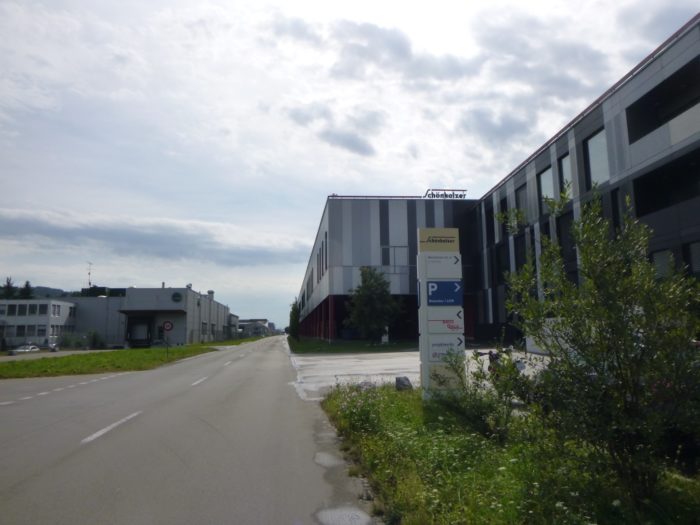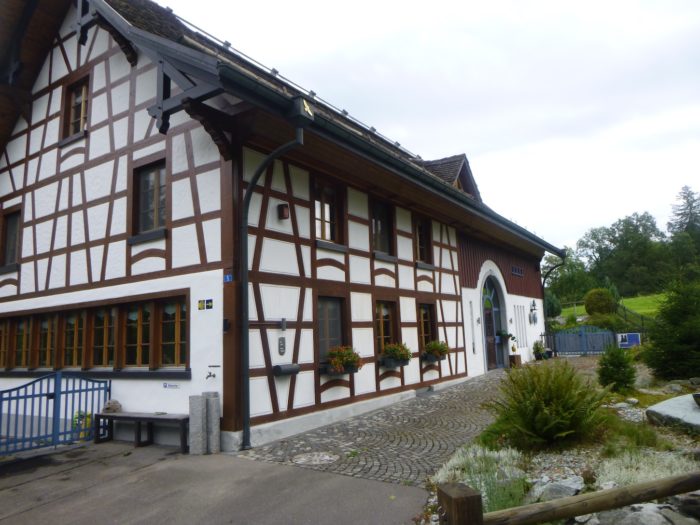Through the countryside of Thurgau Canton
DIDIER HEUMANN, ANDREAS PAPASAVVAS

We divided the course into several sections to make it easier to see. For each section, the maps show the course, the slopes found on the course, and the state of the route (paved or dirt roads). The courses were drawn on the « Wikilocs » platform. Today, it is no longer necessary to walk around with detailed maps in your pocket or bag. If you have a mobile phone or tablet, you can easily follow routes live.
For this stage, here is the link:
https://fr.wikiloc.com/itineraires-randonnee/de-marstetten-gare-a-munchwilen-par-la-via-jacobi-4-152999720
|
Not all pilgrims are necessarily comfortable using GPS or navigating routes on a mobile device, and there are still many areas without an internet connection. For this reason, you can find several books on Amazon dedicated to the major Via Jacobi 4 route, which runs through the heart of Switzerland and over the Brünig Pass. The first guide leads pilgrims through the German-speaking part of Switzerland up to Fribourg, while the second continues through French-speaking Switzerland to Geneva. We have also combined these two books into a compact, lighter, and highly practical version. While the descriptions have been slightly condensed, they remain detailed enough to guide you step by step along the way. Recognizing the importance of traveling light, this latest edition has been designed to provide only the essentials: clear and useful information, stage by stage, kilometer by kilometer. The stages have been carefully adjusted to ensure accessibility and alignment with available lodging options. These books go beyond simple practical advice. They guide you kilometer by kilometer, covering all the crucial aspects for seamless planning, ensuring that no unexpected surprises disrupt your journey. But these books are more than just practical guides. They offer a complete immersion into the enchanting atmosphere of the Camino. Prepare to experience the Camino de Santiago as a once-in-a-lifetime journey. Put on a good pair of walking shoes, and the path awaits you.
|

|
 |
If you only want to consult lodging of the stage, go directly to the bottom of the page.
Thurgau Canton in Switzerland is not generally considered to be among the list of the most prestigious or upscale Swiss cantons. With a population of about 270,000 and its capital, Frauenfeld, hosting approximately 25,000 residents, the canton is modest in size compared to more populous or economically prosperous Swiss regions. In terms of religion, Thurgau is historically predominantly Protestant, although there is also a significant Catholic minority. The distribution between the two denominations varies by region and locality within the canton. Traditionally, rural areas tend to be more Protestant, while urban zones may have a more diverse religious population.
The picturesque countryside of Thurgau unfolds like a living canvas, where nature reigns supreme and the landscape is sculpted with verdant dales and rolling hills, golden fields, and shimmering rivers. Economically, Thurgau stands out for its dynamic industrial fabric. Innovative companies, true pillars of the local economy, excel in various fields such as cutting-edge technology, agribusiness, and machinery manufacturing. Their invaluable contributions have elevated the region to the status of an economic powerhouse, thereby creating jobs and boosting regional prosperity. The emblematic towns of Frauenfeld and Kreuzlingen, while less dazzling than Swiss metropolises, host modern industrial centers and thriving business zones. These oases of economic dynamism reflect the region’s vitality and its ability to adapt to the challenges of the modern world. However, it is not this industrialized part of the canton that you will explore today. Instead, you will pass through vast countryside dotted with picturesque small villages, where time seems to have stood still. Here, life is paced by the cycle of the seasons and the age-old traditions of the inhabitants, mainly farmers who cultivate the land with love and devotion. This area, somewhat removed from major urban centers and neighboring cantons, develops its own rustic and authentic charm. It is a true haven of peace where the simplicity of everyday life meets the serenity of the surrounding nature.

Difficulty level: The route follows gentle elevation changes (+223 meters/-116 meters). There are no significant difficulties along the entire route.
State of the Via Jacobi: In this stage, paved sections compete with paths in equal measure:
- Paved roads: 9.1 km
- Dirt roads : 9.2 km
Sometimes, for reasons of logistics or housing possibilities, these stages mix routes operated on different days, having passed several times on these routes. From then on, the skies, the rain, or the seasons can vary. But, generally this is not the case, and in fact this does not change the description of the course.
It is very difficult to specify with certainty the incline of the slopes, whatever the system you use.
For those seeking « true elevations » and enthusiasts of genuine altimetric challenges, carefully review the information on mileage at the beginning of the guide.

Section 1: Crossing the Thur, a beautiful and significant river

Overview of the route’s challenges : a course with no particular challenges.

If you have spent the night in the village, then it is time to resume your journey toward Märstetten station, marking the start of today’s stage.

|
Leaving the oversized station, your steps will guide you on the same road as the day before, but in the opposite direction, plunging you once again into an industrial atmosphere.
|
 |
 |
| Soon, the air is filled with the hum of multiple industries that populate this small agricultural corner of the country. However, the factories are not numerous. It resembles more a fabric of large service enterprises. |
 |
 |
At the place known as Muggenwinggel, you will cross the bus stop, which undoubtedly contributes to the development of this region.
|
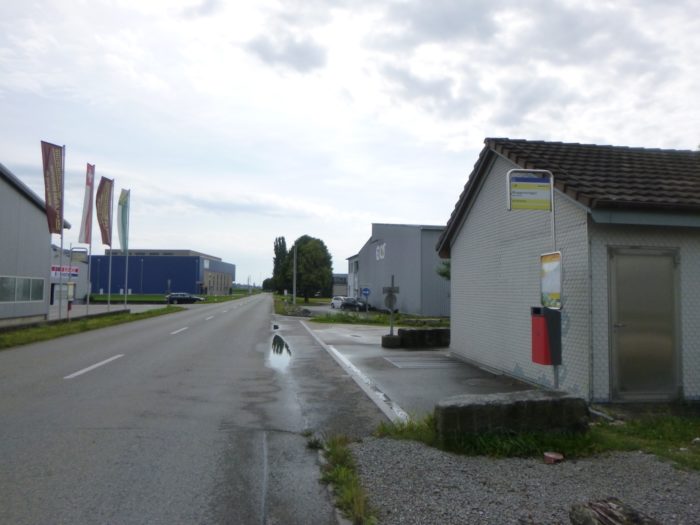 |
 |
After leaving the mild bustle of the factories, the Via Jacobi takes a distinctive turn and heads towards the cantonal road. There seems to be a certain buzz here, likely indicative of quite a dynamic local economic activity.
|
 |
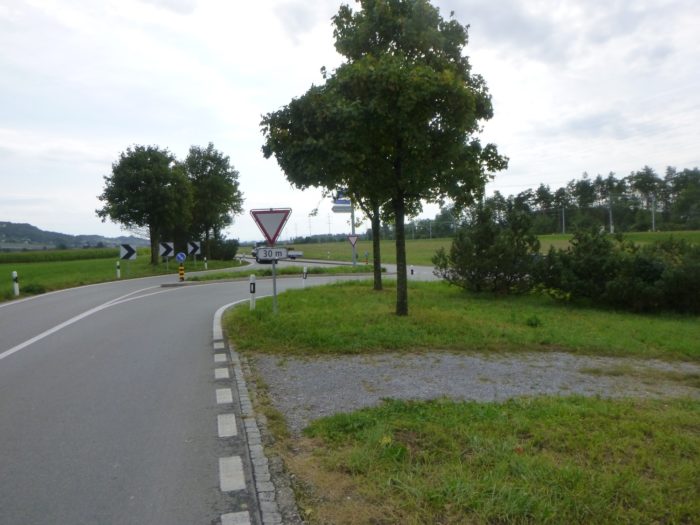 |
| Here, the Via Jacobi indulges in a little pleasure, a sort of improvised gymkhana, passing through a tunnel to avoid the cantonal road and the railway line. |
 |
 |
| Emerging from this subterranean interlude, it gently climbs a small hill to bypass the obstacle as if to catch its breath… |
 |
 |
| … before losing itself in the mysterious confines of a dense undergrowth. This is where you find yourself, contemplating the vastness of the journey ahead. At some 2,335 kilometers from Santiago de Compostela, the goal seems distant, barely attainable, like an irresistible invitation to continue this endless adventure. |
 |
 |
| A wide path stretches out, seemingly sinking peacefully into a shaded forest, where the majesty of deciduous trees reigns supreme. There is little room here for the timidity of modest shrubs; instead, imposing beech trees rise with remarkable stature, accompanied by their companions—field maples and tangled hornbeams—in a natural ballet. |
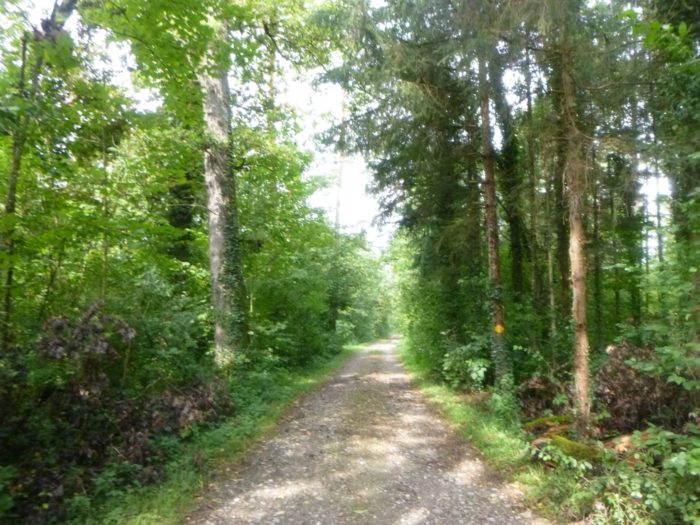 |
 |
| Each step takes the walker deeper into this symphony of greenery, where sun rays struggle to pierce through the dense foliage, creating a gentle atmosphere. |
 |
 |
| As you advance, the density of trees gradually thins out, giving way to a clearing bathed in a softer light. |
 |
 |
| Shortly thereafter, the path, like a determined explorer, carves its way through a grassy expanse, meandering reluctantly between tall rows of corn, almost always undignified and flavorless. |
 |
 |
| Soon, the path reveals itself beyond the borders of the forest and fields, joining the road taken by travelers toward Märstetten-Amikon. On a narrow strip of land, it traces its path with quiet assurance, bordering the road like a faithful traveling companion. |
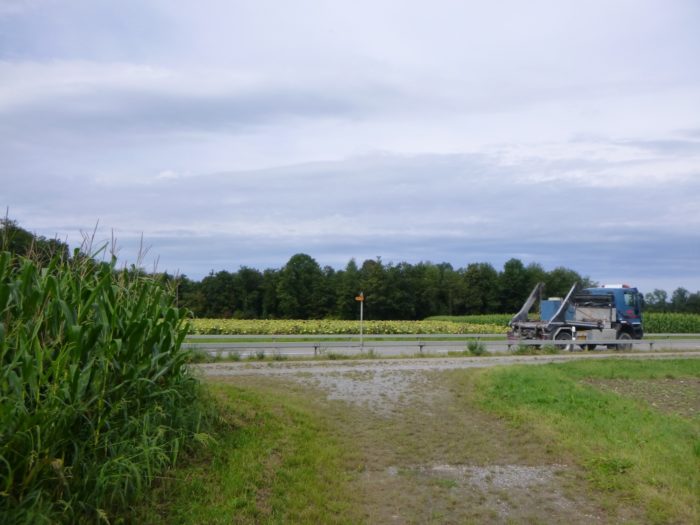 |
 |
| The attentive gaze then embraces the panorama unfolding before it. Amikon, sitting peacefully at the foot of the hill, appears on the horizon like a benign mirage. The outlines of the village blend harmoniously with the undulating silhouette of the surrounding hills. |
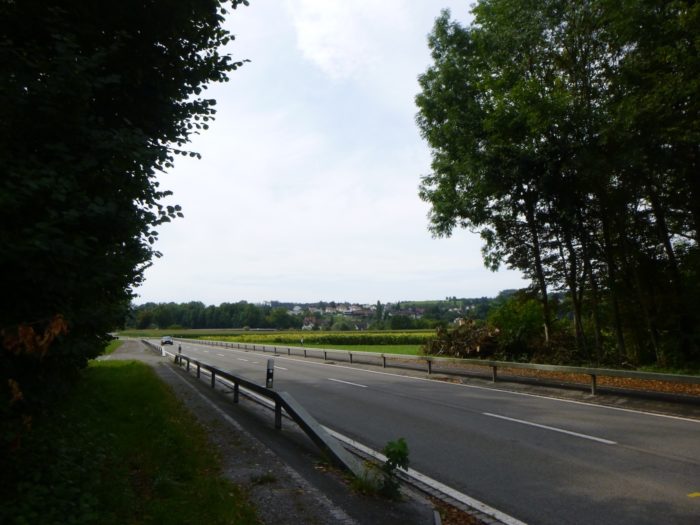 |
 |
| Continuing its course, the road takes a turn, guiding the walker toward a remarkable engineering feat: the grand bridge that majestically spans the calm waters of the Thur River. |
 |
 |
| This river, a truly imposing watercourse, originates from the heights of the Säntis massif in the canton of St Gallen. Like a silver thread, it meanders through the lands of the canton of Thurgau, which proudly bears its name, before continuing its journey through the canton of Zurich, until it merges into the turbulent waters of the Rhine. |
 |
 |
| In the peaceful village, the delicate stream of Hünikerbach winds like a soft whisper through the small valley that you are about to ascend upon leaving this tranquil haven. |
 |
 |
| Here stand the proud typical houses of the canton, silent witnesses to a sophisticated architecture characteristic of each region in Eastern Switzerland. For in these lands, construction is not left to chance; in German-speaking Switzerland, the rules are strict. In Thurgau, half-timbering dominates, but shingles are also prevalent, imbuing the entire eastern region of the country with their picturesque charm. The village grocery store, a true local institution, finds its place here, offering an indispensable service to the community, a grocery likely used also by neighboring hamlets. |
 |
 |
At the very heart of the village, the Via Jacobi, a faithful sentinel of the pilgrims, takes on new momentum, now heading towards Holzhäusern, about fifty minutes from here, higher up in the valley.

| The road, in its journey, grazes the heights of the village, pausing briefly in front of the communal fountain, whose clear waters may murmur ancient stories and forgotten legends. |
 |
 |
| Then, it resolutely engages in a more sustained ascent, following the steep slope of the Hünikerbach stream, whose gentle splashing accompanies each step of the walkers. |
 |
 |
Section 2: In the meadows, along the farms of Thurgau

Overview of the route’s challenges: uphill course, but the climbs are not very demanding.

| Through the meadows, which are true pastures, charming groves of deciduous trees nestle, creating a natural canvas where the green hues of the meadows and the shimmering foliage of the trees blend harmoniously. Further up, the road gracefully crosses the Hünikerbach stream, providing travelers with a poetic respite by its murmuring waters. |
 |
 |
| This discreet and peaceful road can be traversed with surprising ease, as if it were offering itself to the traveler with warm and welcoming hospitality along the dense deciduous hedges. |
 |
 |
| Further along, the road crosses the picturesque village of Hürnikon, where colorful farms stand proudly, like rural jewels nestled in the folds of verdant hills, bending under their steeply pitched, shingle-covered roofs weathered by time. |
 |
 |
| The Via Jacobi, true to its course, intersects here with a more imposing road, continuing its journey through the picturesque countryside. It then guides the traveler toward a neighboring hamlet, like a North Star showing the way to new horizons. |
 |
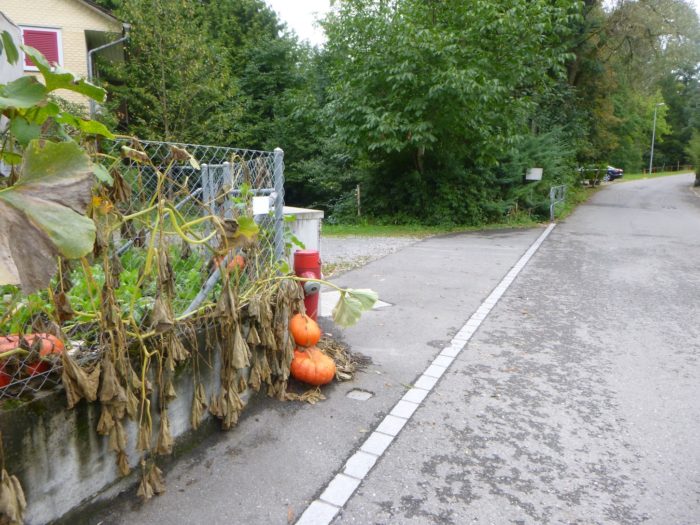 |
| The road soon rejoins the stream, a faithful travel companion that meanders with endless grace through the wooded hills. Its clear, limpid waters reflect the daylight, creating captivating and enchanting plays of light. |
 |
 |
|
Then, the road heads further toward the hamlet of Hampfacker, where one cannot help but notice the undeniable charm emanating from these modest houses, all adorned in the same attire, under their colored paneling, as if they had been designed by the same creative spirit. As one wanders along these European paths, few regions can rival Switzerland in terms of cleanliness and the care given to farms. Almost no tool is left out; it almost feels as if the doorsteps are vacuumed. Only Austria might claim a similar level of attention, where each plot of land seems to be meticulously pampered, reflecting the deep attachment of farmers to their land.
|
 |
 |
As the road gracefully climbs up the hillside through vast meadows, it offers travelers a breathtaking view of the surroundings.
|
 |
 |
Then, like a delicate artisan crafting a masterpiece, the asphalt gives way to a wide path, paved with stones, that elegantly penetrates the surrounding lands.
|
 |
 |
| It is like entering a living painting, a scene of highland pastures where dark green meadows stretch as far as the eye can see. A bench stands there, inviting passersby to pause, sit, and contemplate the timeless beauty of nature unfolding before their eyes. |
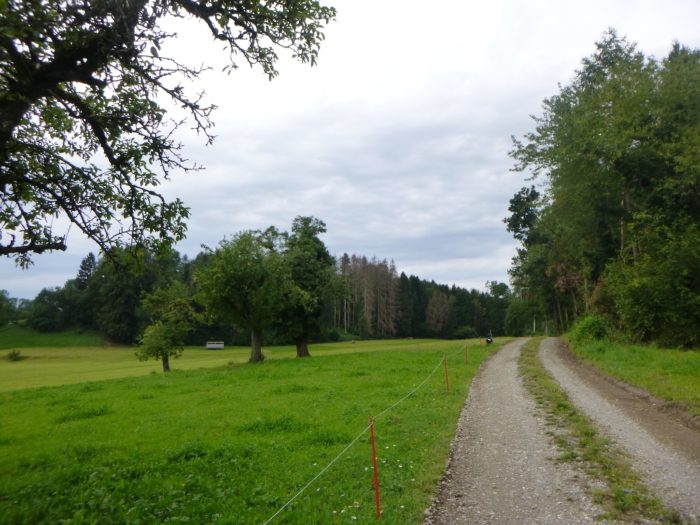 |
 |
| And there, on that proud ridge, the miracle continues, in a setting that marvels and enchants the souls of pilgrims. Silence reigns supreme, a pure and profound silence, only interrupted by the murmur of the wind in the branches and the gentle tinkling of cowbells, as the cows peacefully go about their tasks near the woods. |
 |
 |
| Although you are not very high in altitude, at about 600 meters, the spruces stand tall, adding their majesty to this tableau of serenity and splendor. |
 |
 |
| Further along, the path begins its descent from the hill, and the trees seem to bow gracefully in greeting as you pass, their leaves rustling softly like a warm round of applause. |
 |
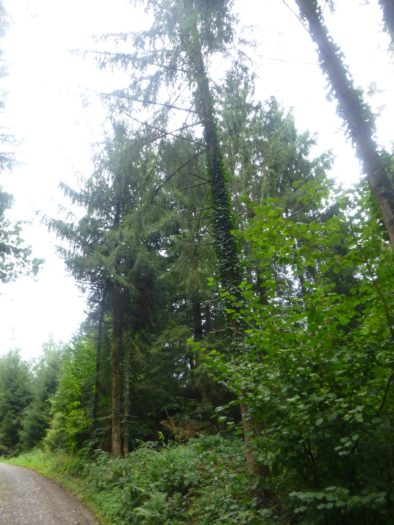 |
| Descending from the hill, you will soon catch sight of the hamlet of Holzhäusern, nestled in the protective embrace of the surrounding trees. Like a jewel hidden in a green setting, the hamlet slowly reveals itself, offering a view of simple and authentic beauty. |
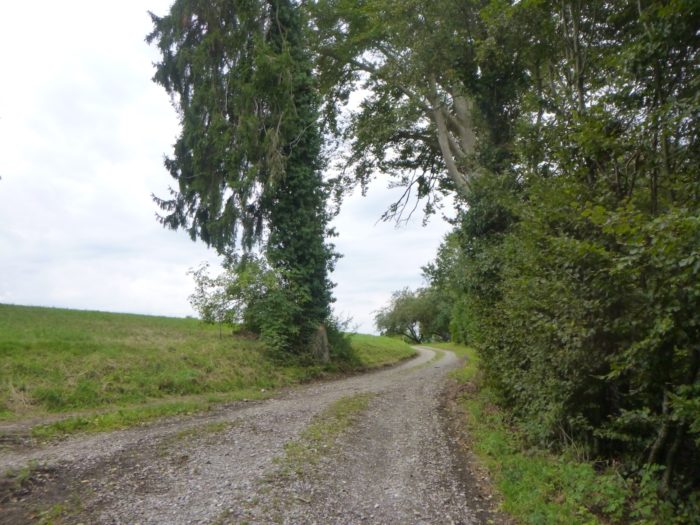 |
 |
| Holzhäusern consists of a few solid farms, lined along the road, silent witnesses to the quiet life that flows in these remote regions. |
 |
 |
| Yet, despite its apparent tranquility, the village seems animated by a certain activity. Here, a school stands proudly, a symbol of knowledge and community, likely gathering children from nearby hamlets to learn and grow together. |
 |
 |
You are now just over an hour’s walk from Tobel, still indicated as the main direction of the route.
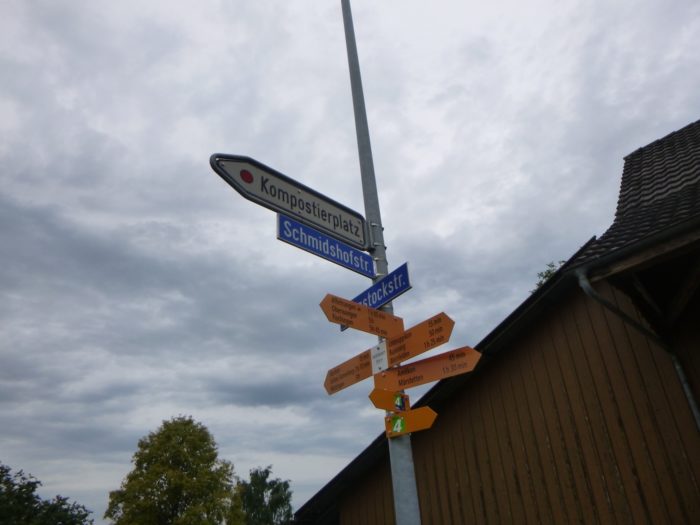
| The road moves away from the village, leaving behind the muted rumble of a gravel pit, a reminder of human activity even nestled in the heart of the tranquil countryside. |
 |
 |
| Then, as a return to tradition, a wide dirt road stretches out before you again, winding through the countryside with discreet majesty. Between the verdant meadows and the corn hedges standing like silent guardians, the path seems honored by their presence, as if each plant bowed its head in respect. |
 |
 |
| This is a truly authentic countryside, of simple and unpretentious beauty, where the scent of fresh grass perfumes the air and tickles the senses with a heady delicacy. |
 |
 |
| Soon, the Via Jacobi makes a stop at Maltbach, where a restaurant invites travelers to pause behind its colored paneling. Here, the return to a busier road is felt, recalling the proximity of civilization while preserving the quiet essence of the surrounding countryside. |
 |
 |
| You are now an hour’s walk from Tobel, in a village setting imbued with tranquility, where serene farms seem to watch over the well-being of their inhabitants, their flowered balconies adding a touch of color to the whole. |
 |
 |
| The route then continues along the strip of land by the road, over half a kilometer. Here, Simmental cows seem to be the favorites, although this is not always the case. The meadows also house many Holsteins, but the gray Braunvieh, so typical of Eastern Switzerland, is more discreet. |
 |
 |
Section 3: In the beautiful countryside and near the large villages of Thurgau

Overview of the route’s challenges: a route with no major difficulties, but somewhat more undulating.
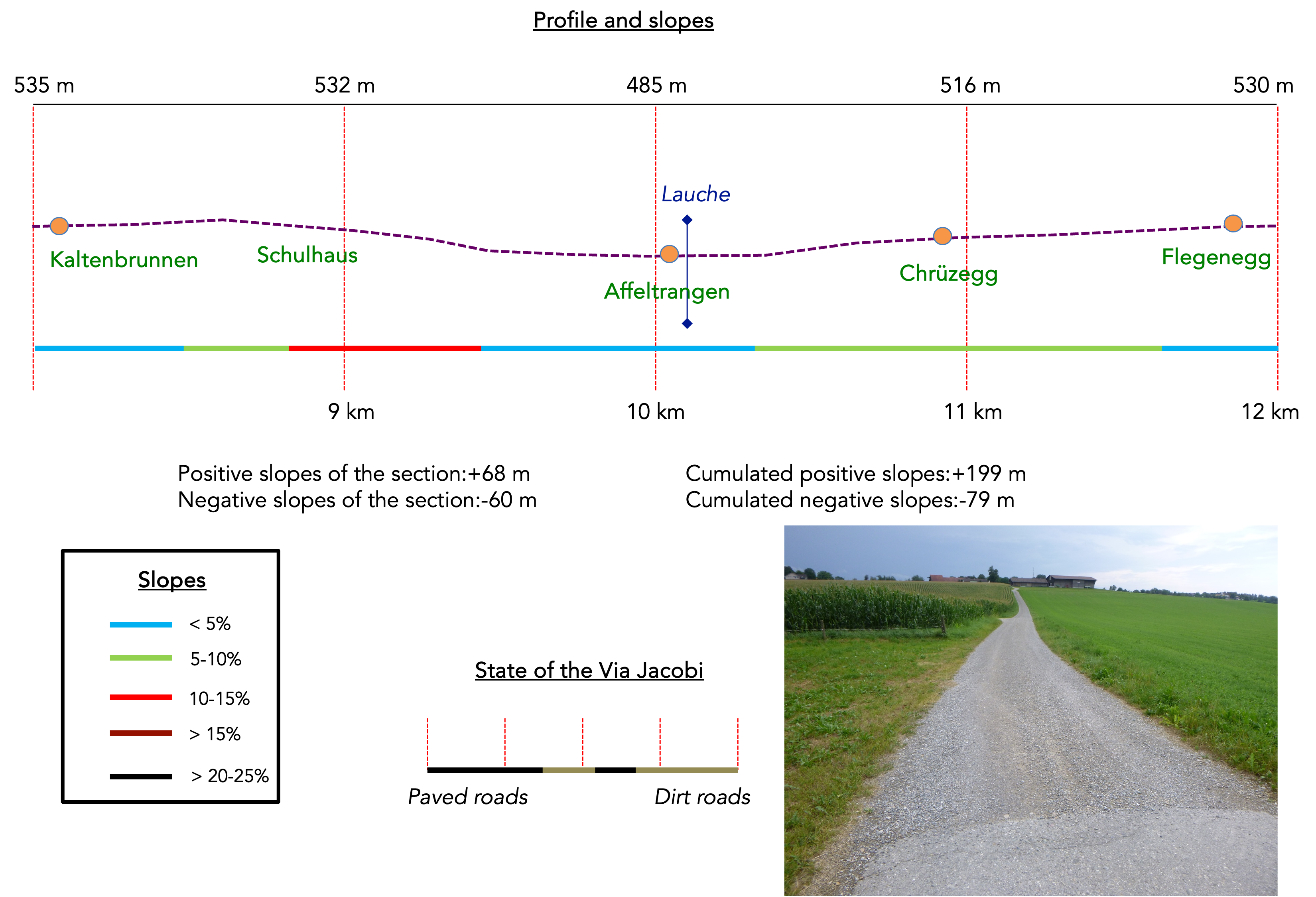
| Further on, the road meanders up to Kaltenbrunnen, immersed in the vastness of the countryside, dotted with peaceful cattle. |
 |
 |
At the roadside, as if emerging from another era, stands the tiny St Jacobus Chapel, a late 18th-century edifice. This little architectural gem, with its welcoming bench outside, invites passersby to take a meditative break, a moment suspended in time.

| Here, the Via Jacobi veers away from the bustle of the main road to follow a smaller side road, promising regained tranquility. |
 |
 |
| It is a straight road, laid out with almost mathematical precision through the meadows, leading travelers to Schulhaus. |
 |
 |
| Schulhaus, as its German name suggests, is a school located next to a large park, a place of learning and play where children’s laughter adds life and joy to the gentle, tranquil landscape. |
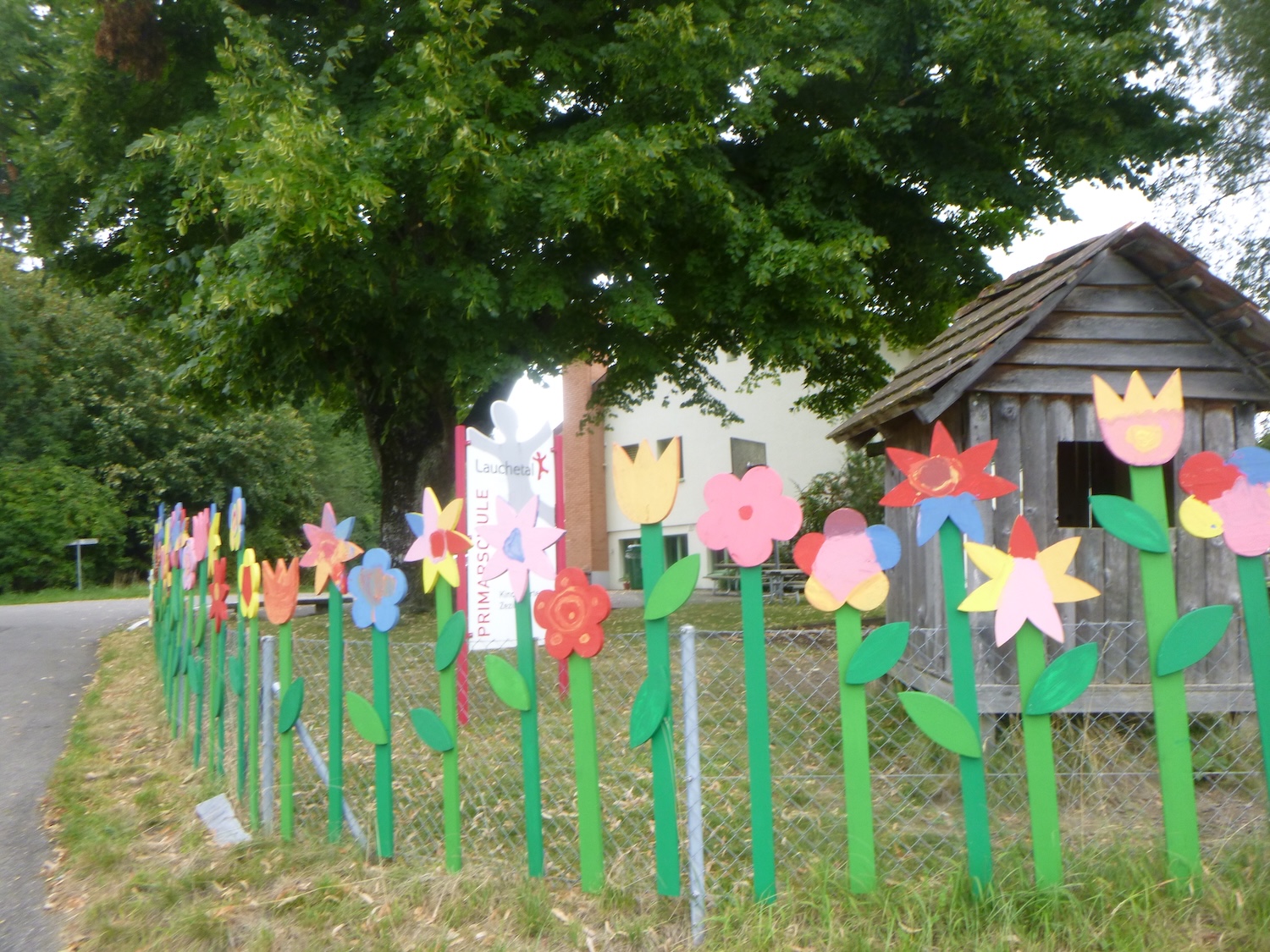 |
 |
| Faced with an unmarked crossroad, where roads diverge without revealing their destination, you find yourself in a predicament. The potential directions stand before you, silent, and in a gesture as ancient as travel itself, you resort to chance: a coin toss. You choose a road that leads into a seemingly more welcoming woodland. However, after an uncertain advance devoid of any directional signs, you meet neither guide nor soul who could illuminate your route. The solitude of this place only heightens your perplexity. In a strategic retreat, you decide to retrace your steps back to the school, naively hoping to find someone there who can dispel the veil of uncertainty weighing on your journey. The wait until recess seems endless, but it finally provides an opportunity to seek the teacher’s help. Unfortunately, she is as unfamiliar with the direction to take as you are. What to do? Determination drives you to return to Kaltenbrunnen, with the faint but persistent hope of finding an informed soul. And there, as if by a miracle, a villager finally directs you: take the left road near the school. This episode underscores the importance of a basic knowledge of German in these German-speaking Swiss regions, where foreign languages are rare gems. This adventure highlights a surprising gap in the path’s signage, leaving one to wonder: wouldn’t it be wise to place a Compostela scallop shell or a yellow signpost here? There seems to be a clear field of action for cartographers from the Friends of the Way of St. James or Schweizmobil to prevent such mishaps for pilgrims. This experience prompts us to reflect on the importance of planning, using maps, or guides before embarking on the paths of adventure. Although Switzerland is dotted with signage, sometimes superfluous, there are moments when the necessary indication is missing. This is the second time since our departure from Konstanz that we have lost our way, a misadventure that has never happened to us in France or Spain. Finally enlightened, you follow the Via Jacobi which veers left, descending towards the plain… |
 |
 |
| …until you discover a familiar dirt path, adorned with the precious markings of the way. A sigh of relief escapes your lips as you confidently proceed along this marked route. |
 |
 |
| The path, broad and rocky, descends determinedly through the fields, flirting with the edge of a dense wood that looms on the horizon. |
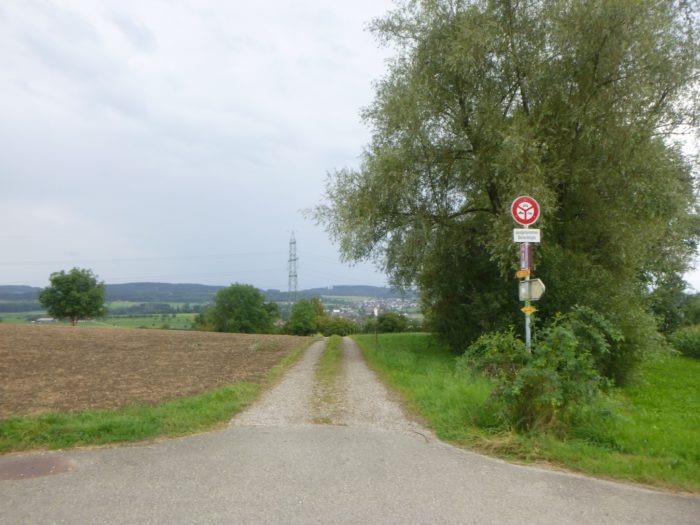 |
 |
|
At the end of this descent, the path finally meets the cantonal road, a convergence point for paths and destinies.
|
 |
 |
| The road then leads you to the base of the large village of Affeltrangen, home to some 2,800 souls, and near the village of Tobel, which houses about 1,600 inhabitants. These localities stretch out along the cantonal road, their urban fabric gradually rising up the hillside that dominates the region. |
 |
 |
The Via Jacobi crosses the Lauche stream but refuses to engage with the cantonal road that crosses the village, thus discreetly continuing its own route.
|
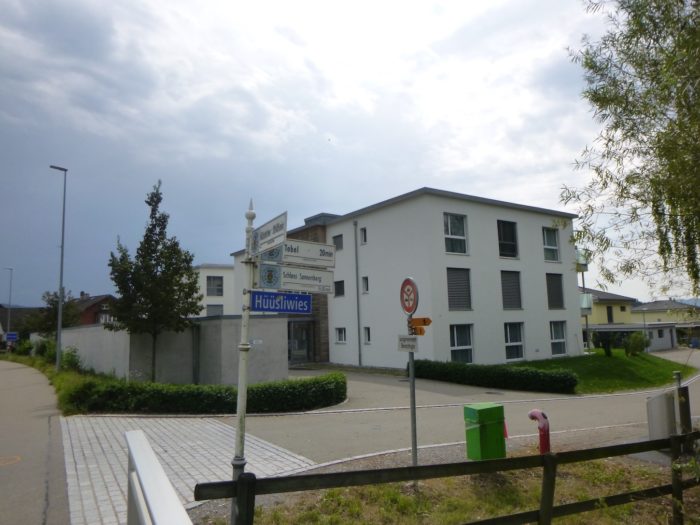 |
 |
A narrow road escapes at a right angle, following the sinuous course of the stream for about a hundred meters, thus defining the periphery of the village and skirting the newer developments.
|
 |
 |
| Then, with the determination of a surveyor, it abruptly turns to follow the contours of the peripheral houses of the small town. |
 |
 |
| To your right stretches the countryside, bare and peaceful, while to your left the locality looms, with the slender spire of its church at the center. |
 |
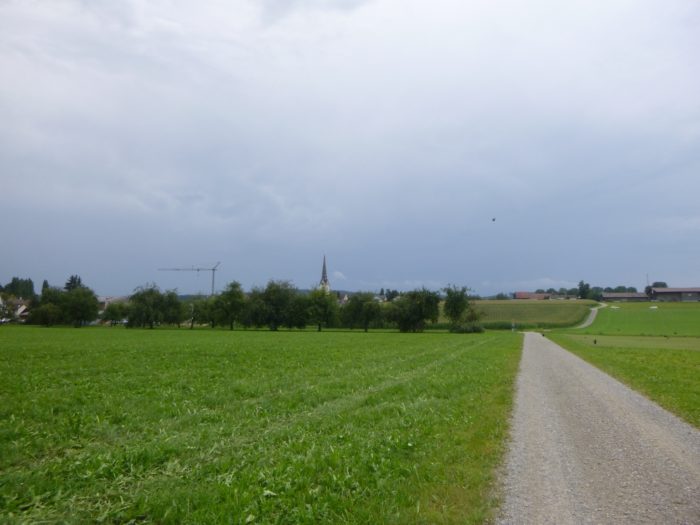 |
Further on, an intersection appears with another road. The Via Jacobi persists in its straight line, a constant here in this initiatory journey.
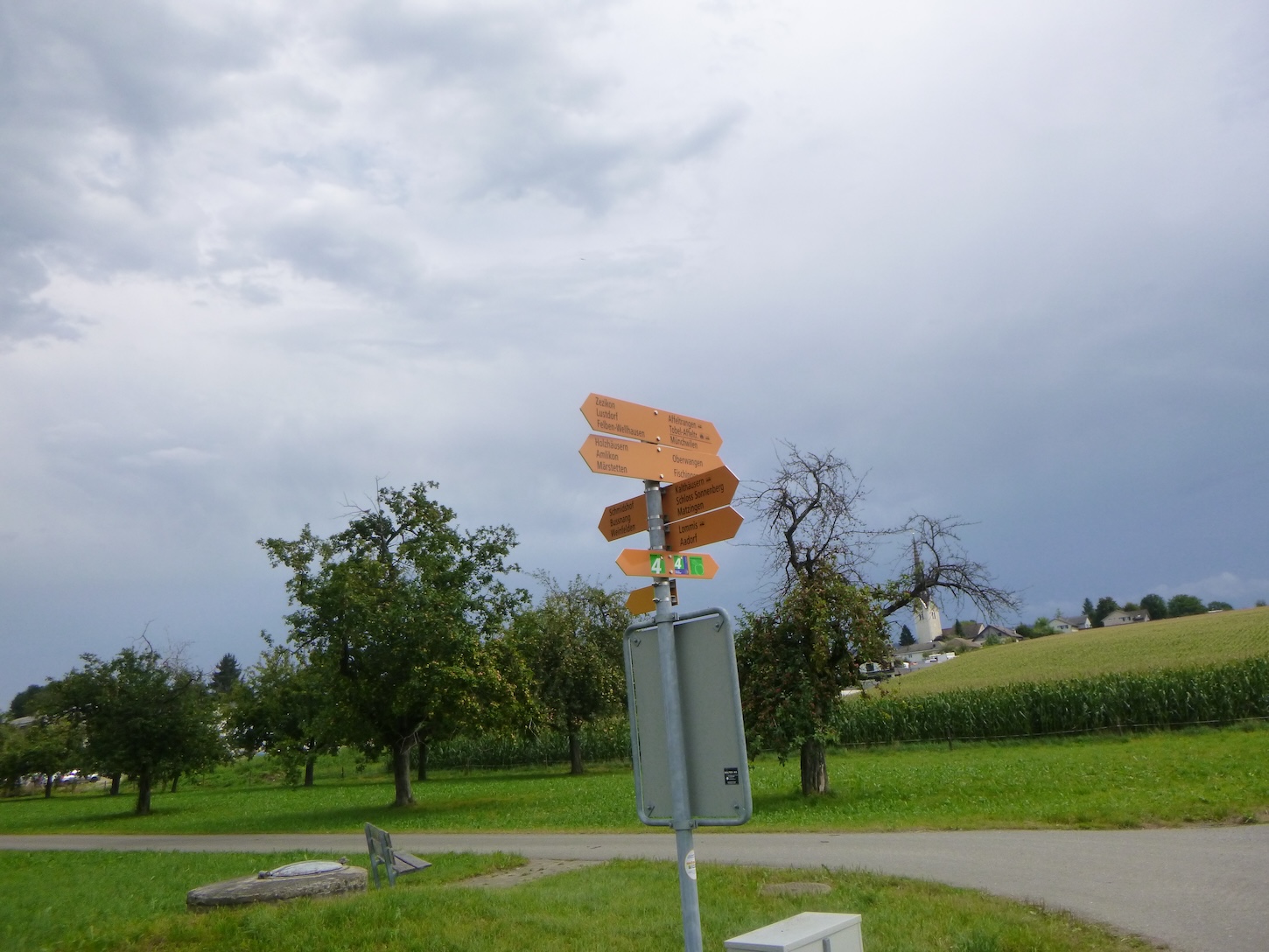
| Now, it’s the dirt road that takes over from the asphalt, as the slope becomes more pronounced, as if to test the tenacity of the walkers. |
 |
 |
| Now, the church stands out clearly in the landscape, and at a new intersection with a road, the path gains altitude, climbing towards a vast complex of farms that seem lost amid cornfields. |
 |
 |
| Higher up, the path emerges at the rural hamlet of Chrüzegg, where the air is perfumed with the enchanting scent of fertile soil and authentic countryside. |
 |
 |
At the heart of the hamlet stands a prominent directional sign. From here, it is possible to reach Tobel, although the incentives to do so are rare. Accommodations are scarce, as are dining options. The signs pointing in the direction of Tobel now give way to those pointing towards Münchwilen/Fischingen, toward your destination for the day.

| Behind a flowered garden, a trail winding through the grass boldly climbs to the top of the hill, starting directly from a farm. Here, graze the gray Braunvieh cows, true jewels of Eastern Switzerland, living symbols of the richness and beauty of these lands. |
 |
 |
| A scarcely marked trail bravely rises through tall grasses, climbing the hillside. During the mowing season, the task becomes arduous, the path camouflaging itself among the bundles of cut grass. But there, at the summit, like a beacon in the storm, you will see a directional sign, your only reference in these moments of confusion. |
 |
 |
| At the top of the meadows, a small paved road lazily stretches out, offering a haven of rest under the chestnut trees where a bench stands, a savior for weary travelers. |
 |
 |
| From there, a wide vista opens over the rolling hills and the distant horizon, a mesmerizing panorama that captures the essence of Thurgau’s pastoral beauty. |
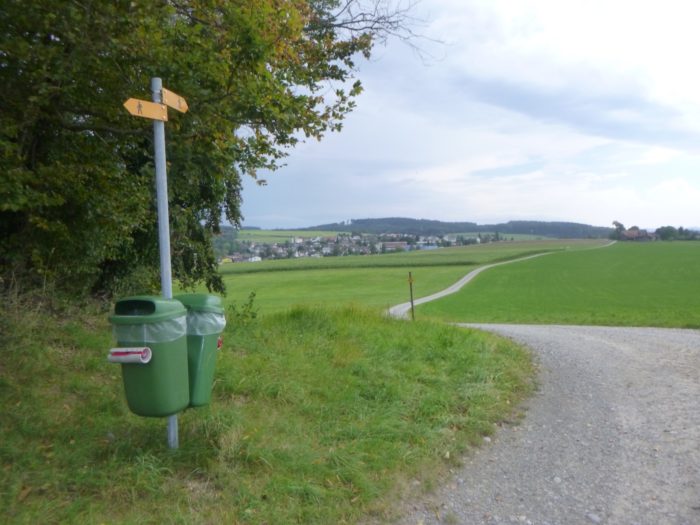 |
 |
| Further on, after a new turn towards Tobel that you discreetly bypass, the path continues straight, ascending the slopes to reach the farms of Flegenegg. |
 |
 |
| Flegenegg, a place imbued with charm and poetry, welcomes its visitors with a magnificent farmhouse shaded by majestic lime trees. Your new general direction is now Fischingen, another step in your journey of 2315 kilometers to Santiago. Isn’t that a significant advancement? |
 |
 |
Section 4: Meadows, cornfields, and undergrowth in the beautiful countryside of Thurgau

Overview of the route’s challenges: a route without any difficulty.
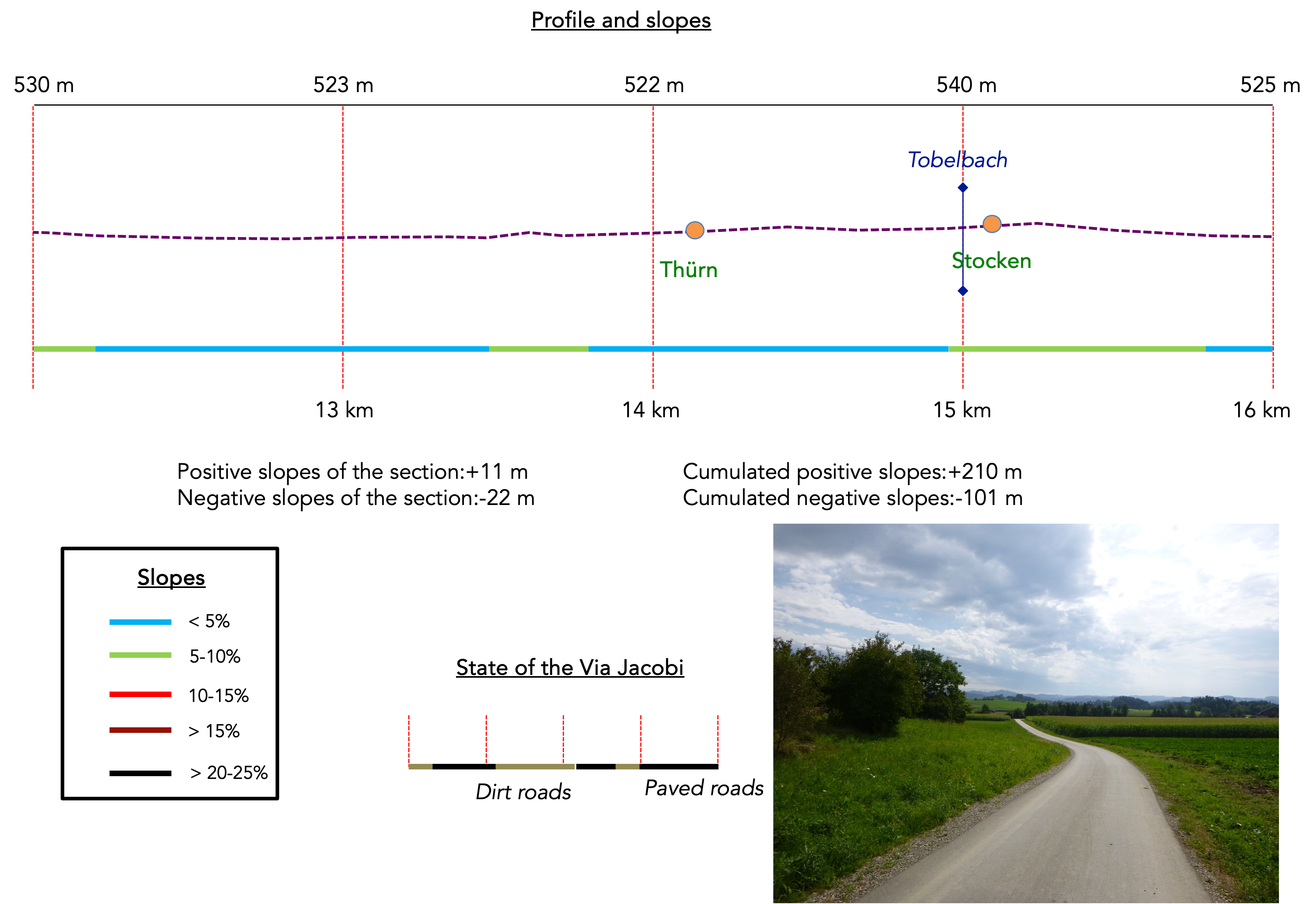
| The path winds its way through vast cornfields stretching almost as far as the eye can see on the hill, leaving only modest portions of meadows to emerge here and there. |
 |
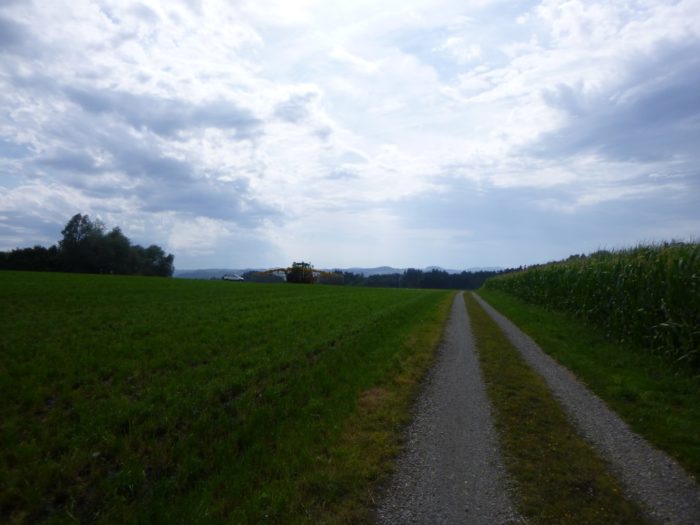 |
| Further down, the Via Jacobi meets a winding road seemingly inexorably leading to a nearby village. However, this part of the journey deliberately avoids villages, preferring the comforting silence of the countryside. |
 |
 |
| It follows the course of the road, and although the landscape maintains its unchanging appearance, more crops than pastures are noticed. Corn reigns supreme here, and it’s hard to tell if other crops unfold in different seasons. |
 |
 |
| In the distance, on the horizon, imposing silos rise, marking the passage of the cantonal road. These are the storage facilities of the company Tanklager Tägerschen, used for storing petroleum products. These tanks, real eyesores in the landscape, have a total capacity of approximately 250 million liters. |
 |
 |
At the bottom of the descent, a bench welcomes you near an imposing wrought iron cross, surmounted by a golden Christ full of compassion.
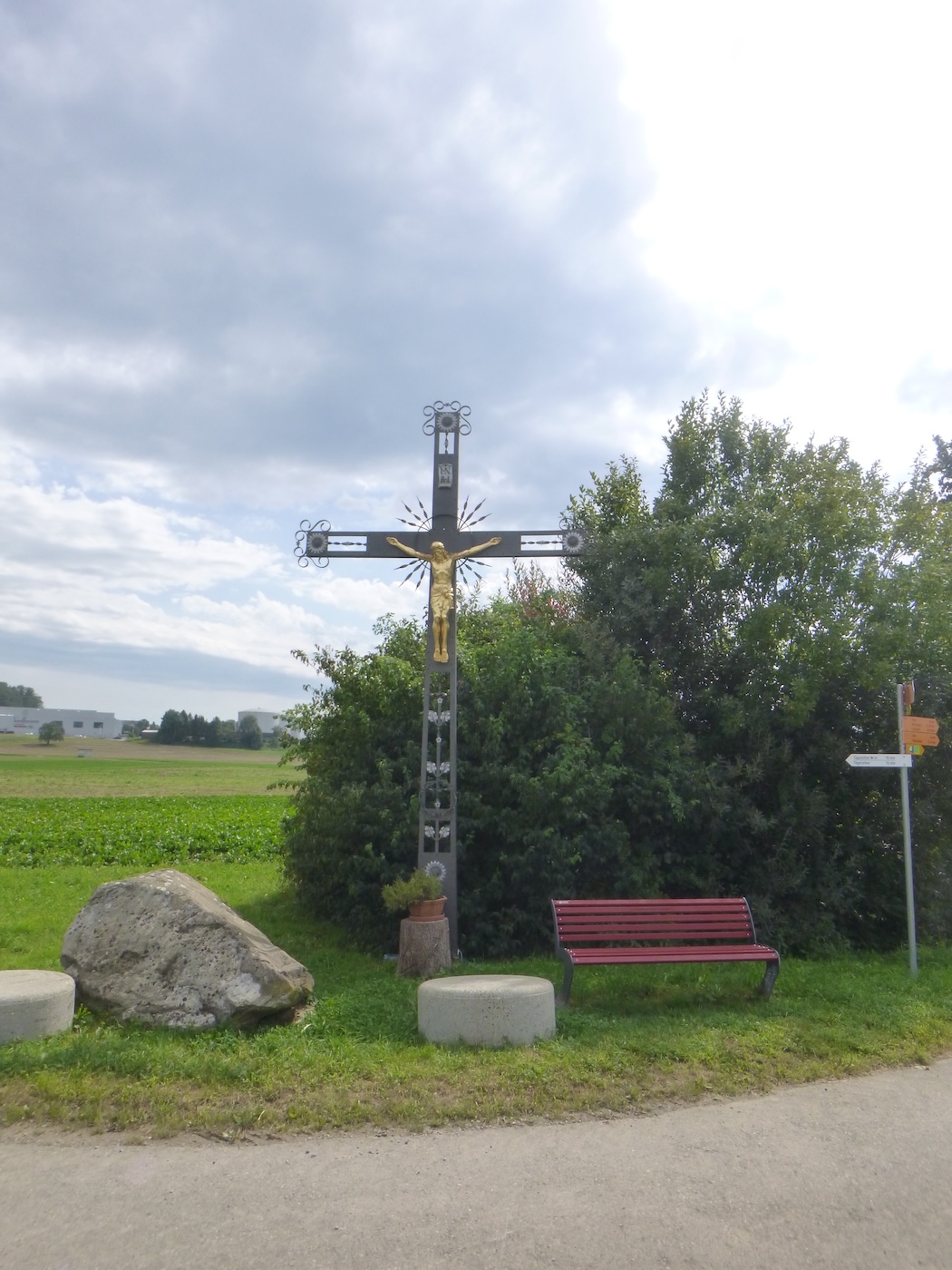
| Next to the crucifix, a majestic sign stands, announcing Münchwilen as the end of your day’s stage, a 1-hour and 45-minute walk away, and your next goal, Thürm, just 25 minutes from here. |
 |
 |
| From this sacred spot, the gaze embraces a gentle panorama, where the green hills blend into the infinite sky. The road stretches like a backbone through the fertile countryside, seeming to pierce the fabric of the bucolic landscape. |
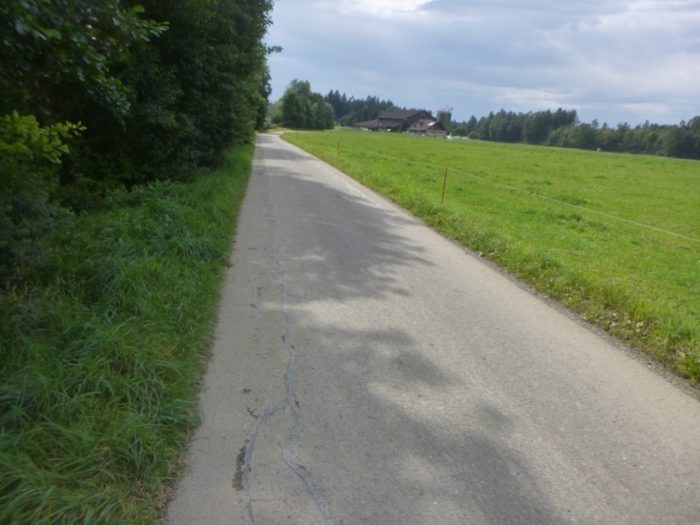 |
 |
|
It advances confidently towards the majestic farm of Waldhof, whose imposing barns and aligned stables testify to the prolific life that animates these places.
|
 |
 |
|
From this imposing farm, a gravel path takes over, determinedly plunging into the heart of the green meadows, its irregular course offering a striking contrast to the symmetry of the surrounding pastures.
|
 |
 |
|
This wide path steadily advances toward the hedgerows of deciduous trees in the undergrowth, as if to plunge further into a trail leading into the mysteries of the surrounding nature.
|
 |
 |
The looming shortcut crosses a dark undergrowth, where the carpet of dead leaves crunches underfoot, and where the saplings, tightly packed together, struggle to reach the light filtering through the branches of the majestic beech trees that dominate the canopy.
|
 |
 |
After a few twists and turns through this unwelcoming wood, the trail finally rejoins the wide gravel path, as if to catch a breath of fresh air after a fleeting immersion in the mysteries of the forest.
|
 |
 |
| As the path resumes its familiar trajectory, it plunges again into the wooded tranquility, where the majestic beech trees spread their leafy branches, the tall spruces stand proudly, and the hornbeams weave their benevolent shade, creating a tableau of timeless beauty that delights the senses with every step. |
 |
 |
| It meanders with infinite grace, offering on one side the enchanting magic of the undergrowth, where the whisper of the wind in the foliage and the birdsong create a natural symphony, while on the other side stretches the countryside, vast and serene, dotted with green meadows and golden fields. In the distance, the silos stand like silent sentinels. |
 |
 |
| At times, the landscape transforms into a tableau of rare splendor as meadows and forests intertwine in a harmonious embrace, forming a patchwork of greenery with infinite nuances. The delighted eye savors these lush greens blending and merging into an irresistible palette of colors, captivating the soul. |
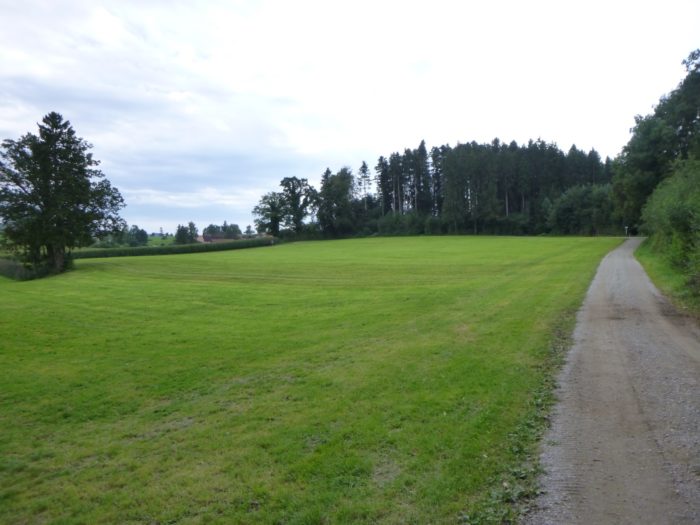 |
 |
| Further on, the path turns again towards the imposing silos, inexorably drawing the curious gaze of the walker. Their dominant presence intrigues and raises questions: what do they contain? What is their role in this peaceful landscape? At every turn of the path, their imposing silhouette dominates the horizon, fueling curiosity waiting to be satisfied. |
 |
 |
| So, like a theater changing its scenery, the landscape gradually transforms as the path approaches the village of Thürn. |
 |
 |
At this point, you are a little over an hour from Münchwilen, heading towards Fischingen on the cantonal road coming from Tobel.

| At the intersection, a small tarred road climbs steeply towards a new hill. The spectacle that unfolds then seems straight out of a postcard, a true idyllic panorama as often found in German-speaking Switzerland: meadows of vibrant green stretch as far as the eye can see, punctuated by isolated farms that silhouette on the horizon, giving this landscape an aura of tranquility and timeless beauty. |
 |
 |
| The road continues further along the ridge, offering breathtaking views near the picturesque farms of Auenhof, in meadows that seem painted with a brighter green than Ireland itself. |
 |
 |
| Then, it begins a gentle descent towards Stocken, offering a breathtaking view, as the countryside spread out before your eyes seems extraordinary, and the grass is so vividly green that it almost bursts with life. |
 |
 |
| At the bottom of this descent, where the Tobel stream sneaks discreetly between tall grasses, you feel a deep connection with the surrounding nature. The soothing murmur of flowing water and the absolute calm here create an atmosphere imbued with serenity and mystery. |
 |
 |
| In Stocken, as the Via Jacobi approaches urban centers, one is amazed to see the emergence of new constructions, reflecting the gradual development of this region. Despite this proximity to civilization, the atmosphere remains serene, preserving the authenticity of these preserved places. |
 |
 |
| Yet, calm still reigns, and the road majestically unfolds through green meadows and cornfields, offering magnificent views from the crest before briefly rejoining a dirt path. . |
 |
 |
| On the horizon, civilization looms, announcing the imminent presence of larger urban centers in the plain. The road surface then transforms, the beaten earth giving way to poor asphalt, as the road begins its descent from the hill. |
 |
 |
| It becomes a visual competition between the meadows populated by gray cows and the cornfields, beauty bursting from all sides in this landscape of enchanting sweetness. |
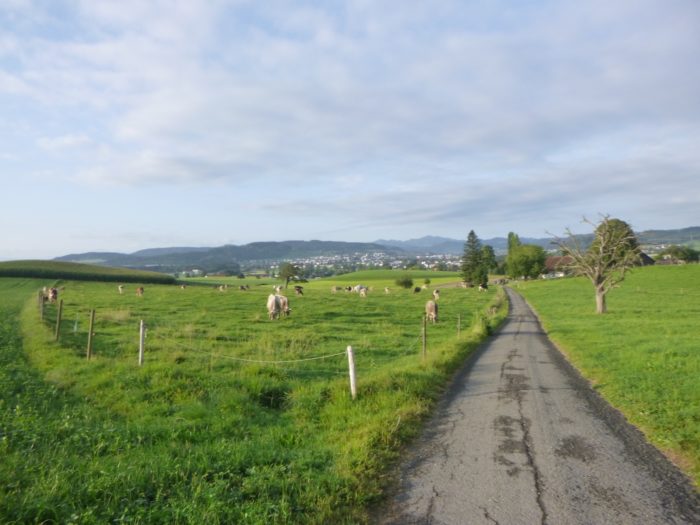 |
 |
Section 5: Returning to civilization

Overview of the route’s challenges: a route without any difficulty.

| Soon, the road emerges onto the heights of St. Magarethen, offering a surprising view between the old farms with rustic charm and the new housing developments that have sprung up here like mushrooms after the rain. |
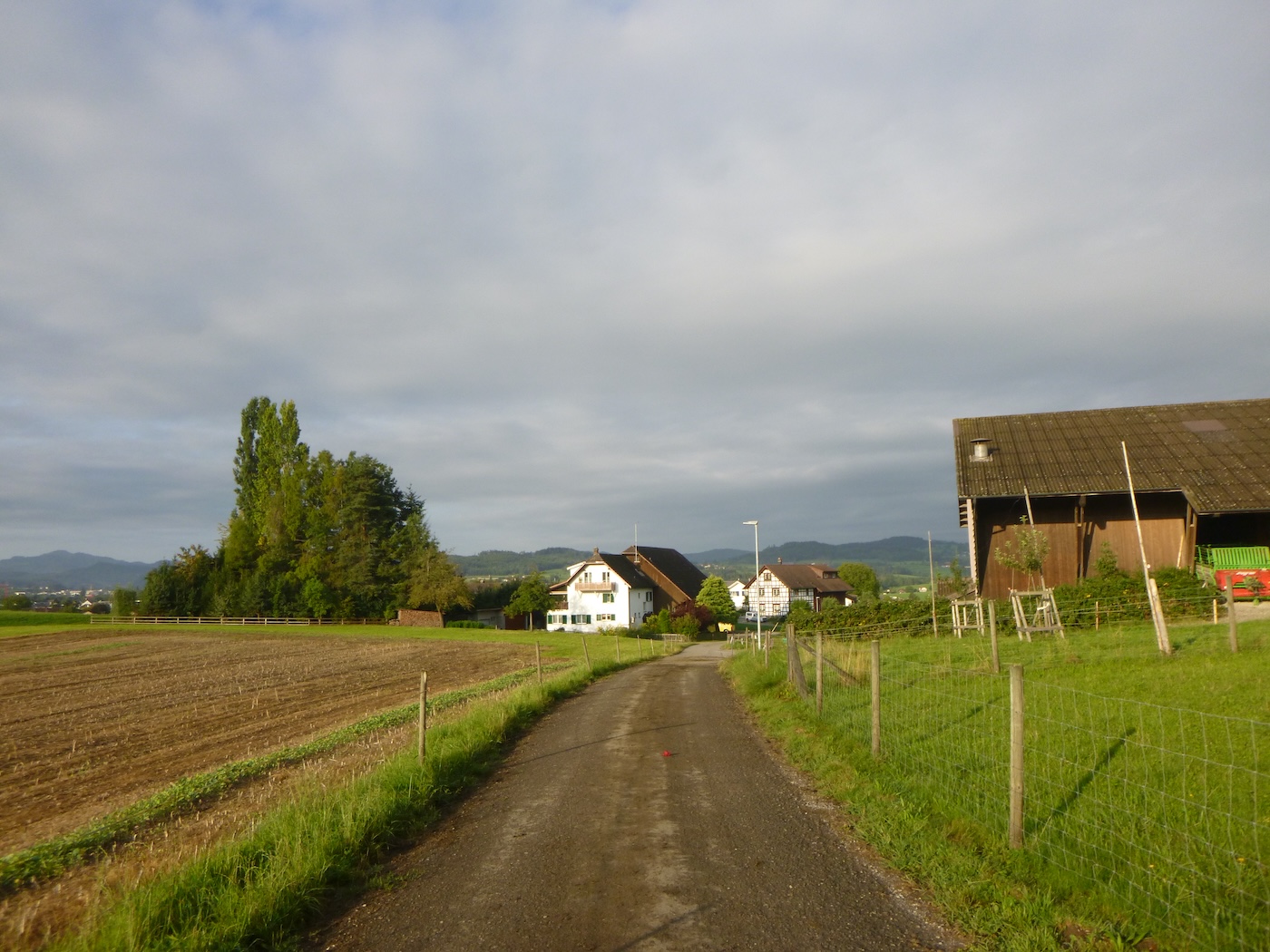 |
 |
| At the top of the village, the new houses stand proudly, bearing witness to the rapid growth of the region. However, as is often the case throughout German-speaking Switzerland, these new constructions harmoniously coexist with the old houses and farms, forming a landscape where past and present intertwine with elegance. |
 |
 |
| The road then runs alongside the Chapel of Ste Marguerite, a historic building dating back to the late 17th century, where Gothic and Baroque styles blend in architectural symbiosis. Once frequented by pilgrims, this chapel bears witness to the rich spiritual heritage of the region. |
 |
 |
| From the chapel, the route transforms into the Pilgerweg, thus testifying to the persistent presence of some pilgrims in the region, before reaching the center of the picturesque village of St. Margarethen, where a warm community of 1,000 inhabitants nestles along the cantonal road. |
 |
 |
| In the old village, you can still discover magnificent examples of traditional Eastern Swiss architecture. Some houses are clad in shingles, reminiscent of the traditions of Appenzell or the canton of St. Gallen. However, most dwellings boast the typical style of Thurgau, with their half-timbered facades, thus bearing witness to the architectural heritage of the region. In the 19th century, about 75% of buildings in Thurgau were half-timbered houses. Although many of them have been demolished or renovated over time, some have been restored to regain their former character. Throughout history, the wealthier opted for stone constructions, fearing fires, while the less fortunate preferred timber-framed houses, which are characteristic of half-timbered houses. These are characterized by spaces between the beams filled with plaster or wattle, an ancient technique inherited from Roman antiquity and maintained in Central Europe since the early Middle Ages, notably in Alsace. |
 |
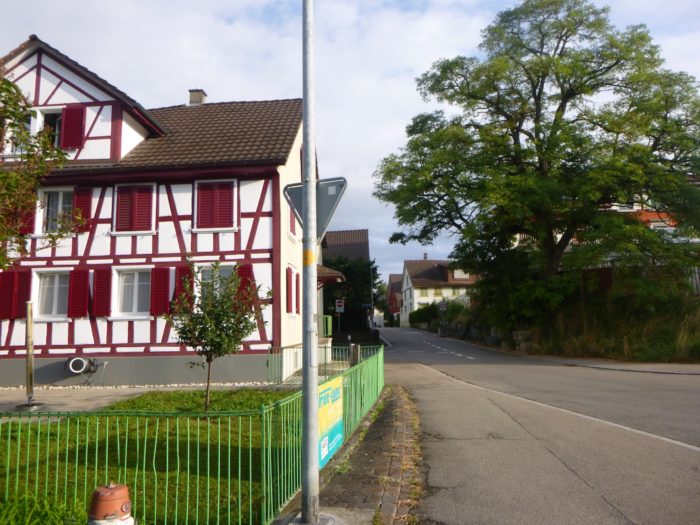 |
| .The Via Jacobi then follows the Ringstrasse, literally the « circular street, » as its German name suggests, elegantly skirting the village, offering pilgrims a panoramic view of the surroundings. It soon crosses the peaceful Chräbsbach stream, adding a touch of serenity to the journey. |
 |
 |
| Shortly after, the road encounters another river, more imposing this time: the Murg, the major river that meanders through the valley with its majestic presence. This watercourse symbolizes both strength and constancy in this gentle landscape. |
 |
 |
At this point, you are only a few steps away from Münchwilen, located between the city and the countryside, where you will stop today.

| A broad path winds along the hedges bordering the river on one side, offering a view of the cultivated lands of market gardeners, near the industrial area of Münchwilen. This juxtaposition of nature and human activity testifies to the diversity of landscapes encountered along the Via Jacobi, where peaceful rurality coexists with urban hustle and bustle. |
 |
 |
| It is recommended to pay particular attention to the trees lining this path, as you will soon pass by a majestic avenue of trees, offering the opportunity to enhance your knowledge of the region’s plant species. Among these trees, you can discover less common species such as slender aspens or massive locust trees, which, although less prevalent in local forests, often find their place near watercourses. |
 |
 |
| Majestic beeches and sycamore maples also abound along this path, sometimes accompanied by the imposing presence of august elms, a species nearly extinct in Europe due to fungal infestations. Thus, even pilgrims less versed in botany can benefit from this true natural history lesson, allowing them to identify the trees encountered along the way. This walk then takes on the air of a true botanical garden, offering an enriching experience that goes beyond simply admiring the landscape. |
 |
 |
| In the hedges, the hornbeam plays hide and seek with hawthorns, wild plum trees, and blood-red dogwoods, creating a changing and surprising botanical tableau. |
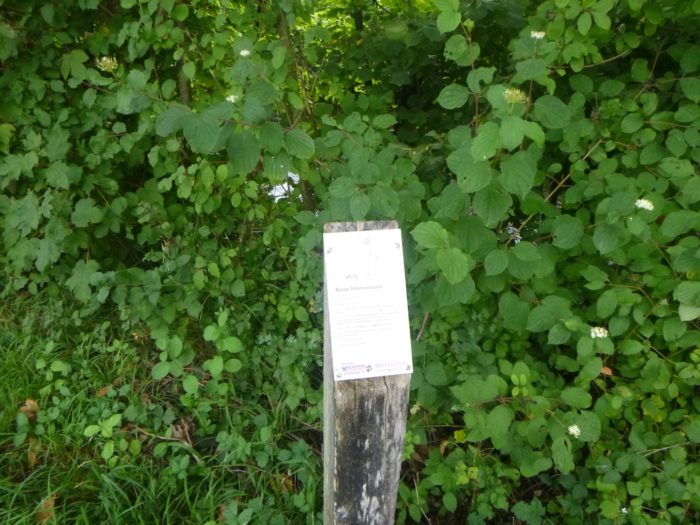 |
 |
| The walk along the Via Jacobi proves to be beautiful and enjoyable, offering pilgrims an enchanted interlude in the heart of nature. Further along, the path enters the private park of Alfred Sutter, where trees peacefully line the riverbanks, providing a haven of tranquility and serenity. |
 |
 |
| Exiting the park, you reach Münchwilen, a town populated by 5,900 inhabitants, where the imposing presence of the Murg, the local river, divides the city while the railway also traverses its territory. |
 |
 |
At the heart of the central square stands an intriguing building: the curious Palace of Justice. Imposing and remarkable, this building, erected in 1906 by architect Albert Brenner, does not go unnoticed. Recently, an extension has been added to it, sparking mixed opinions. This new structure, composed of a sort of woven ceramic work, seeks to establish a direct dialogue with the original building. However, this addition, which establishes geometric, spatial, and structural references, divides opinions: some see it as a bold attempt at modernization, while others perceive it as a discordant intrusion into the urban landscape. It’s up to you to decide! We, however, don’t quite appreciate it.

Accommodation on Via Jacobi
- B&B Alte Post, Bergli 4, Amlikon; 071 651 15 56/076 535 14 80; Guestroom, breakfast
- B&B Keller Lorentz, Oberfeldstrasse 6, Amlikon; 071 650 02 60/078 687 39 99; Guestroom, breakfast
- B&B Andrea Rupp, Mühle 2, Tobel-Tägerschen; 076 595 41 49/079 745 71 56; Guestroom, breakfast
- Homestay Thürm 8, Tobel-Tägerschen; 076 443 48 53; Guestroom, dinner, breakfast
- B&B Susi Legrand, Münchwilerstasse 21, Tägerschen; 078 805 78 07; Guestroom, breakfast
- B&B Claudia Vogt, Rebenstrasse 30, St Margarethen; 078 638 67 57; Guestroom, dinner, breakfast
- Pension zur Elfe, Wilerstasse 35, Münchwilen; 071 966 30 33; Guestroom, breakfast
- Hôtel Münchwilen, Schmiedstrasse 5, Münchwilen; 071 969 31 31; Hotel, breakfast
On this stage, the possibilities of finding accommodation are slightly more abundant than the previous one, even along the way. A supermarket is accessible in Amlikon, and although the path doesn’t pass through Tobel, amenities are also available there. In Münchwilen, all necessary shops are at your disposal. However, even with these alternatives, it is wise to book your accommodation in advance.
Feel free to add comments. This is often how you move up the Google hierarchy, and how more pilgrims will have access to the site.
|
 |
Next stage : Stage 3: From Münchwilen to Steg im Tösstal |
|
 |
Back to menu |









